“This post contains affiliate links, and I will be compensated if you make a purchase after clicking on my links.”
Last Updated on December 1, 2022
Great Dane care is a crucial part of owning one of these big, beautiful dogs. And whether you are a new dog parent or not, taking care of a Great Dane requires special care that is appropriate to the breed.
A Great Dane owner’s role is big in terms of caring for these dogs. And optimal Great Dane care is important to the canine’s wellness and health. Furthermore, proper caring will make an obedient and well-behaved family companion.
In this article, you’ll learn how to take care of your Great Dane properly so it can live a happy, long and healthy life.
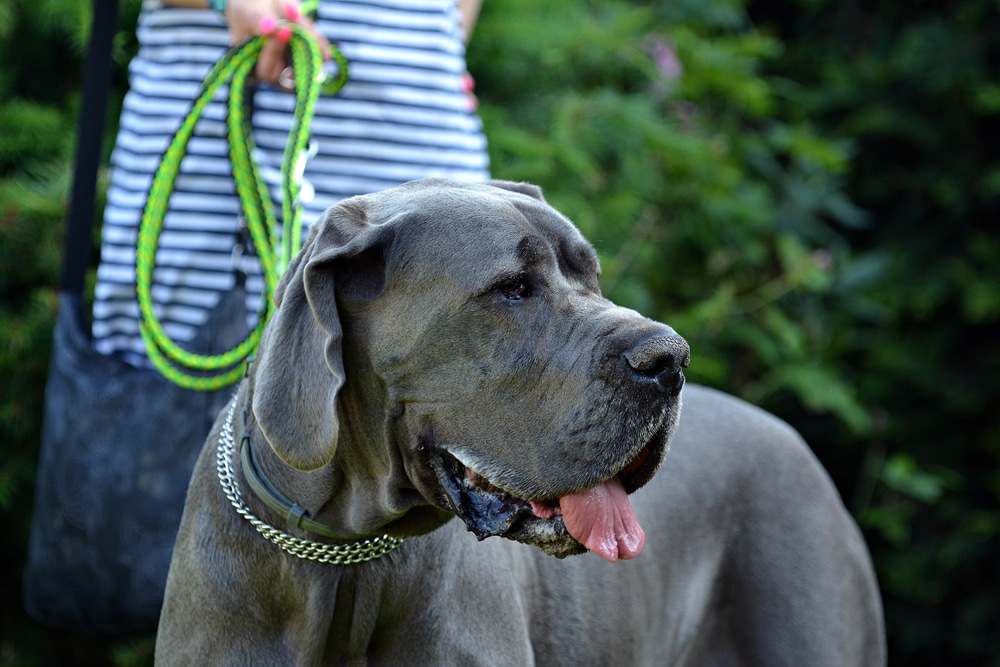
Get To Know Your Great Dane
Great Danes are referred to as “Apollo of Dogs” due to their big and intimidating size. In fact, the tallest dog on earth according to the Guinness World Records, Zeus, is a Great Dane that stretches over 7 feet tall when standing on his hind legs.
On average, a Great Dane’s height can be anywhere from 28 inches to 34 inches. And they can weigh about 100 to 200 lbs. Naturally, male Danes are taller and weigh more than female Danes.
Furthermore, Great Danes grow rapidly. According to the Great Dane Club of America (GDCA), Great Dane puppies on their first year will grow as much as human children in their first 14 years.
With these information alone, you know that you are dealing with a dog that can be as big as or even bigger than humans. And due to the dog’s size alone, Great Dane care can be challenging if not done right.
Great Dane Care Guide
Ensuring these dogs get to grow healthily and live their best life requires guidelines appropriate to the breed. Below, you’ll see the most important parts of Great Dane care to achieve a healthy, happy and safe Dane.
1. Food and Diet
It goes without saying that what you feed your Great Dane has a big impact to their overall health. Since these dogs can grow rapidly as puppies, providing the right amount of nutrition is crucial to their growth.
Aside from kibble, Great Dane dog parents can also feed their dogs wet dog food, raw food and even a home-cooked meal.
Food Requirements
Great Dane food requirements can be a lot different from other dog breeds. For starters, Great Danes should be eating food meant for large canine breeds. Furthermore, puppies and adult Danes should be fed with food appropriate for them. Meaning, puppies should not be eating adult Dane food and vice versa.
The Great Dane diet should be high in proteins and low in fats. The food’s protein levels should not be more than 24% and the fat levels should be somewhere between 12% to 14%.
This type of diet is perfect for Great Danes because it promotes proper bone and muscle growth (especially in puppies) and helps maintain lean mass.
Puppies require more calories to sustain the rapid growth they undergo. However, as adults, fat levels should be reduced in their diet. This is because they’ve already reached their full size and no longer need as much calories as when they were puppies. If their food has more proteins and fat levels, they can develop bone, joint and skeletal abnormalities like hip dysplasia.
How much you feed your Great Dane is also important. Instead of one full meal a day, you should be feeding your Dane twice or thrice a day. Whether they’re puppies or adults, it is not recommended to feed Great Danes only once a day. This can lead to life threatening problems like bloat.
2. Health Issues
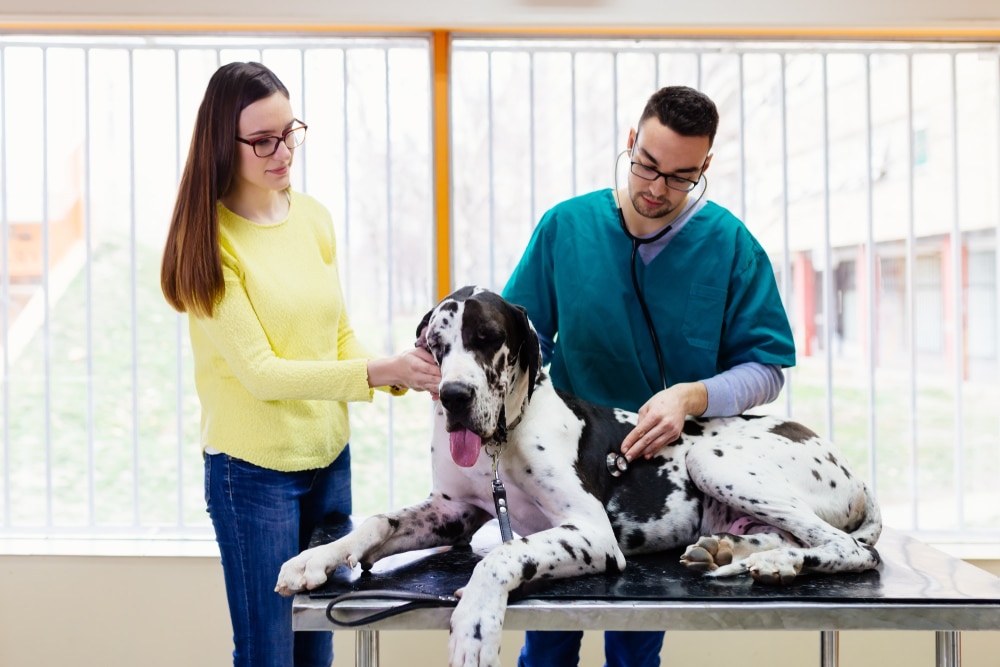
Another important aspect of Great Dane care is learning about the health issues that the breed is predisposed to. The most common issues are bloat, a heart disease called cardiomyopathy, joint and bone diseases like hip dysplasia and osteosarcoma.
As a Great Dane owner, it’s your responsibility to know these health issues and be prepared to deal with them properly. Proper Great Dane care can decrease the risks of such diseases in your dog.
For example, to avoid bone and joint diseases in Great Danes, you must limit your dog’s physical activities and ensure they’re getting the right nutrition from their food. Another good example is dividing your dog’s meal to two or three meals a day, since one full meal will increase the chances of bloat.
Bloat in Great Danes
Bloat is a medical condition where the dog’s stomach fills with gas. When left untreated, the dog’s stomach can twist in itself and block both the organ’s entrance and exit. And it’s a dangerous condition for Great Danes.
In fact, a UK study said that 42% of Great Danes can develop bloat in their lifetime. And they are 8.2 times more likely to die of bloat than any other canine breed.
In order to prevent bloat, Great Dane owners are advised not to give their dogs one full meal a day because they are known to eat rapidly. Furthermore, Great Danes shouldn’t be allowed to play or exercise right before and after eating.
Regular Checkup
For a breed that is predisposed to life threatening health issues, regular visits to the veterinarian is a must. Vaccinations, physical examinations and different lab tests are just some of the things your vet will administer during the visit.
Vet visits are important parts of Great Dane care because they ensure that your dog is in tip top shape. Furthermore, your Great Dane’s vet will be able to help you determine and deal with any form of disease that your dog may have developed before it even gets worse.
3. Exercise
Another side of Great Dane care that goes hand in hand with training, is exercise. Great Danes are a breed that only needs moderate exercises. However, while the Great Dane temperament suggest that these dogs can be lazy, this is not true for puppies.
Great Dane puppies are more playful and active than adults. For them, two to three times of 30 minutes to an hour of exercise will keep them physically fit. But as adults, they need less exercise, just enough to keep them fit and mentally stimulated.
Some of the best types of exercise for your Great Dane to keep them physically fit are walking, hiking, and/or swimming. Some mentally stimulating games you can play with them are fetch, tug of war or hide and seek.
Generally, when you are exercising your Great Dane outdoors, teaching them to walk on a leash becomes a necessity. This is because leash pulling with these dogs can become a big problem.
4. Training
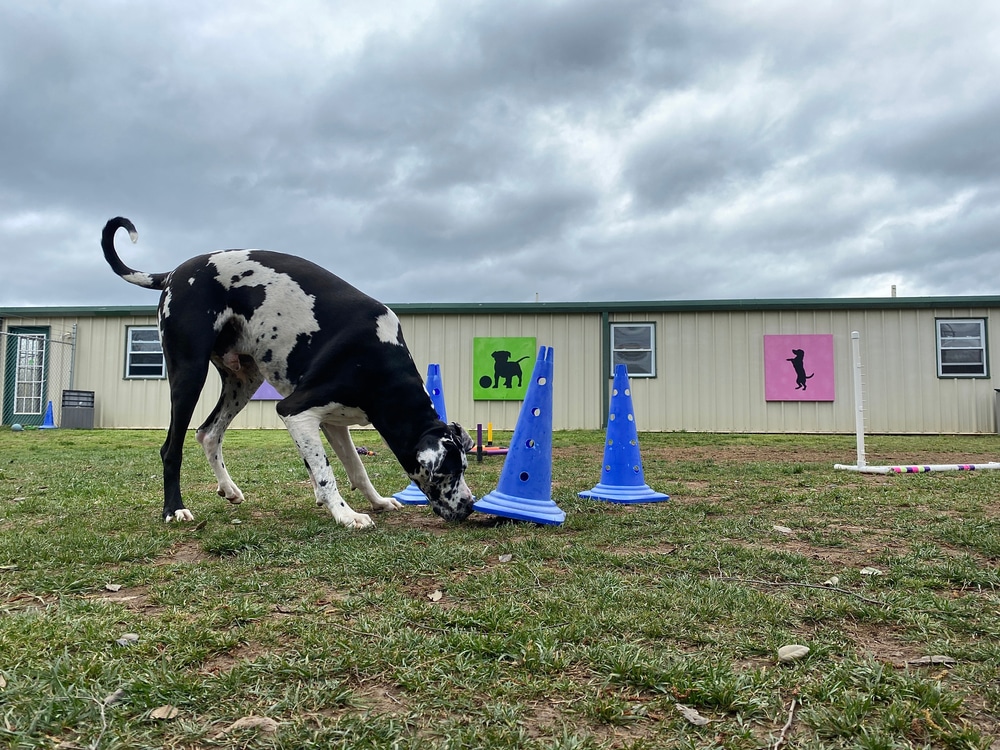
Training and discipline are both indispensable to Great Dane care. Just looking at a Dane’s size alone, you’ll understand why training is necessary.
A Great Dane should undergo training as early as 8 weeks old. Thankfully, Great Dane dogs are known people pleasers and are very loyal to their owners. So you can definitely take advantage of these two characteristics when training your dog.
Some of the most important trainings your Great Dane should undergo are socialization, obedience training, leash training, potty and crate training. And during training, positive reinforcement is always a good technique to train your Great Dane.
Although Great Dane dogs are naturally amenable, friendly, and sweet tempered dogs, nurturing their good characteristics is still important. A well-trained Great Dane will definitely grow into a happy, healthy and well-behaved dog.
Additionally, training is not only to develop good characteristics and correct bad behaviors, but also a way to build a bond and trust between the owner and the dog.
Socializing a Great Dane
Great Dane training should start with socialization and should be done as early as 8 weeks. These dogs are known to be protective and quite possessive of their owners. And without proper socialization, they can get overly possessive, or worse, aggressive.
Letting your Great Dane meet new people and pets and encounter new environments helps them build confidence and trust. Furthermore, when they’re used to being put in new and unfamiliar situations, they will know how to behave correctly and navigate the world properly.
Furthermore, it can curb aggressiveness at a young age because the dogs learn to coexist with others, whether it be other dogs or people.
Additionally, if you want your Great Dane to be a part of dog shows, you must ensure your Great Dane is socialized properly. As advised by the American Kennel Club (AKC), Great Danes are required to be friendly and lively for dog shows. And aggressive or timid Great Danes are not admissible.
Dealing with Separation Anxiety
Part of Great Dane care is dealing with the breed’s separation anxiety. These dogs are prone to develop separation anxiety because they are social dogs and love hanging out with people, especially their owners. Therefore, they do not like being left alone.
Here are a few helpful Great Dane care guidelines when dealing with anxiety:
- Make sure to dedicate at least an hour of daily outdoor activity beside strolling or walking. The activity doesn’t have to be too exhausting. For example, visiting a park where your Great Dane dog can have some good time looking around.
- Keep your Great Dane busy with dog toys when at home. This will help the dog become mentally stimulated and to become less dependent on you.
- When your dog has gone a few hours without you, give them treats and praise them when you get back home. This way, they can associate the experience with something positive.
- Do not scold your Great Dane for reacting a certain way when they get anxious. This will make things worse.
5. Grooming
Great Dane grooming is not as complicated or laborious when compared to other breeds. Great Danes have short and smooth coats. They also have a single coat and are considered moderate shedders.
Unlike breeds with a double coat, daily brushing with a medium bristle brush will mostly help maintain a Great Dane’s single coat. Additionally, brushing can also help with shedding. While Great Danes are considered moderate shedders, they are huge! And a bigger dog only means more fur.
And unless they get in a messy situation, bathing once every 2 or 3 weeks is enough for Great Danes. Since they can be prone to skin conditions, frequent bathing will likely result to dry skin.
Furthermore, drooling can be a problem with Great Danes. If your Great Dane drools, you must clean their mouth with a damp towel twice a day.
Cleaning a Great Dane’s natural floppy ears is also advised. Given the dog’s tendency to develop ear infections, proper cleaning is a must. You can also ask your vet to provide you with some Great Dane dog ear cleaner.
And lastly, since these dogs have short coats, you have to ensure that they’re covered enough during the winter when going out.
6. Ear Cropping
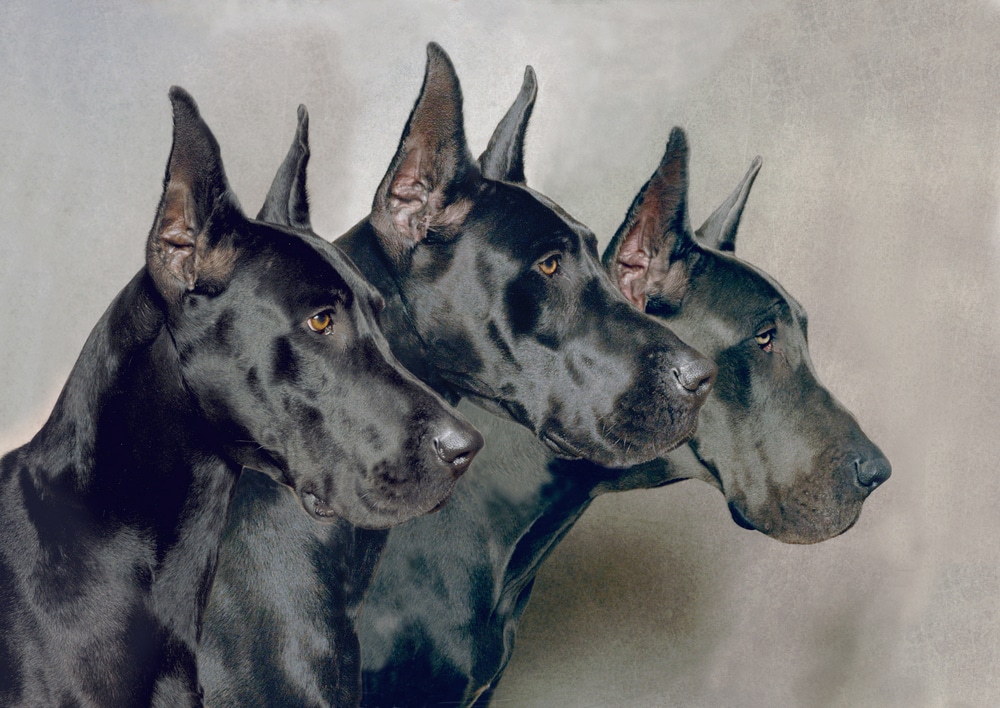
Great Danes were originally bred to hunt wild boars in Europe. And to avoid injury to their natural floppy ears, ear cropping was performed on them.
However, since Great Danes are no longer used to hunt wild boards, modern ear cropping has mainly become a personal and aesthetic preference.
While some claim that ear cropping can help prevent ear infections, there are no studies or researches supporting this claim. Furthermore, up to this day, many experts and veterinarians find the procedure unethical, unnecessary and cruel.
If you wish to do this to your Great Dane, please do your research on the procedure’s pros and cons.
7. Lodging and House Requirements
Lodging and house requirements is important in Great Dane care, especially because they are big dogs and require things that are appropriate for their size.
Great Danes, despite their huge size, are actually great apartment dogs. Since they are docile, friendly, not as active and low-maintenance dogs, they’re a great choice for apartment living.
Furthermore, fences is another thing you should consider as a Great Dane owner. They can easily climb up or jump over usual fences, so investing in taller fences is important.
Great Dane Bed and Crate
Crates and beds appropriate for the Great Dane’s size should also be provided to them to make living comfortable for them.
The Great Dane is prone to joint and muscle disorders, so you must make sure to provide bed and furniture that will make lying down and sleeping comfortable.
Great Dane Care Guide At a Glance
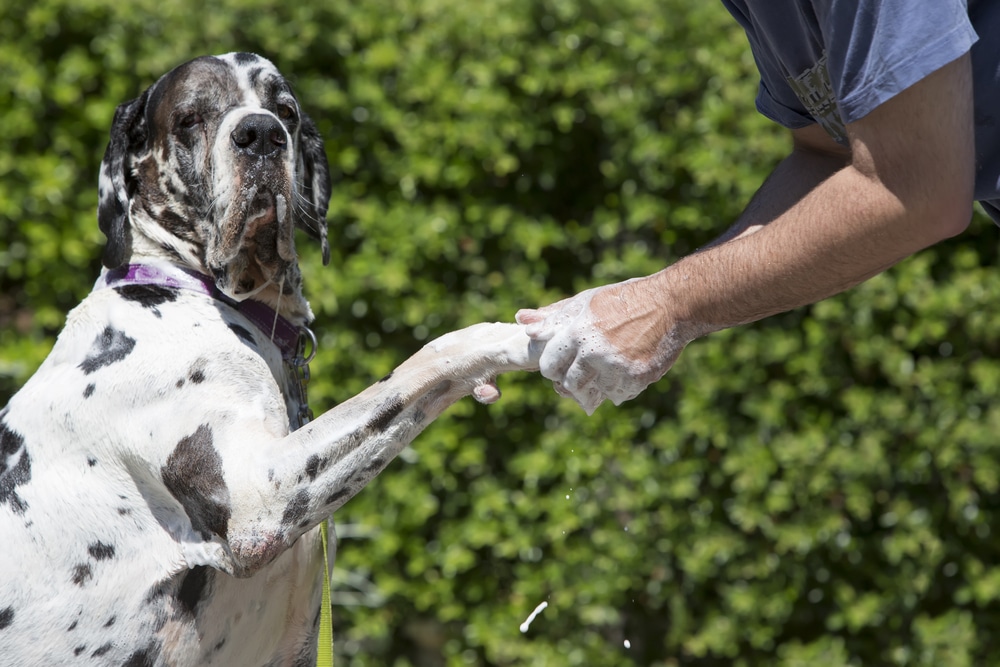
Great Dane care is not a difficult job but it can be demanding, since you are dealing with a huge dog. As compared to other breeds, Great Dane care might seem laborious as the responsibility of Great Dane owners can increase ten folds – financially, physically, mentally and emotionally.
But of course, while the responsibility is big, the love and loyalty that Great Danes give will make it rewarding and an overall great experience. And all the Great Dane care, no matter how huge, in comparison to other breeds, is worth it.